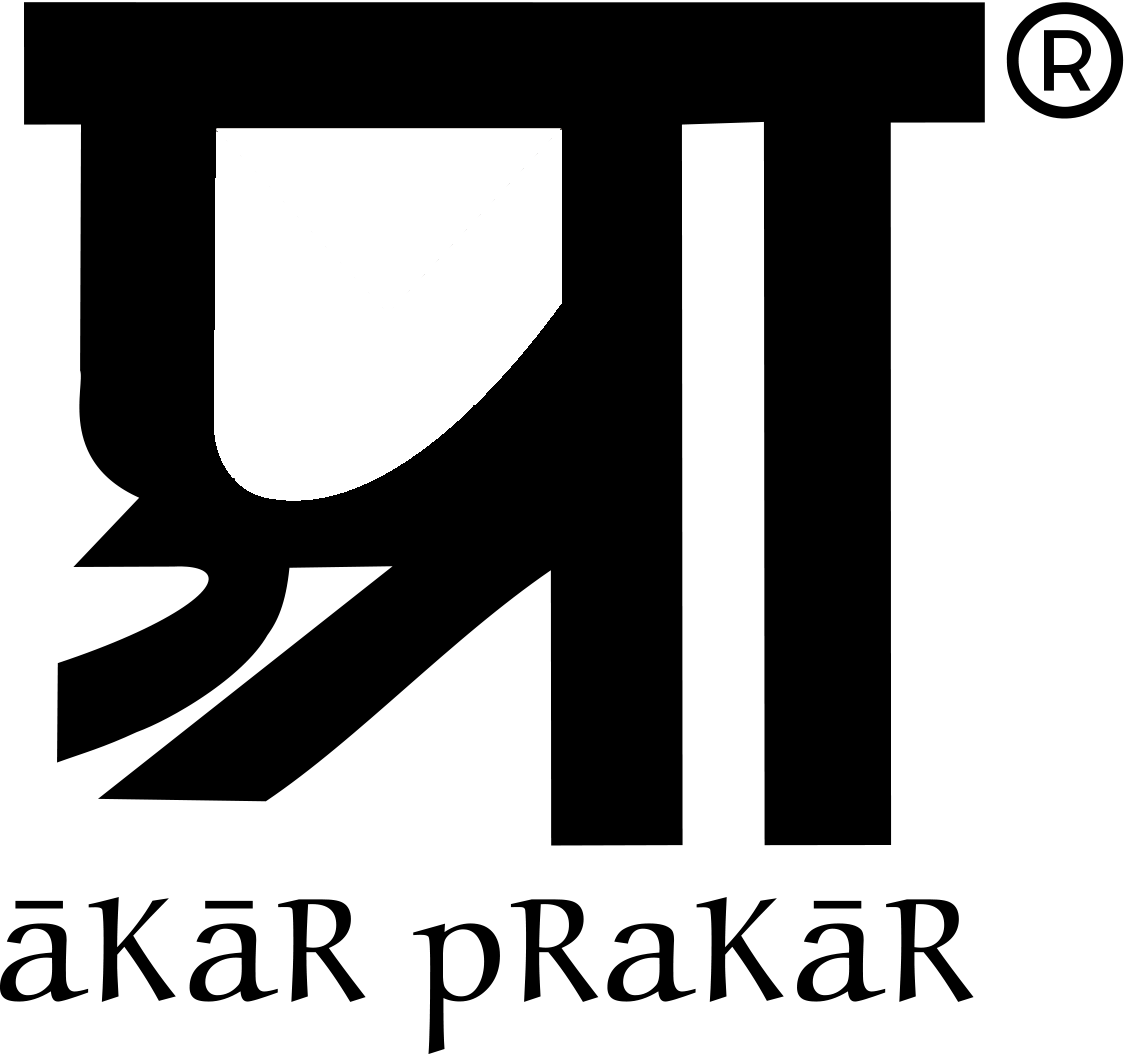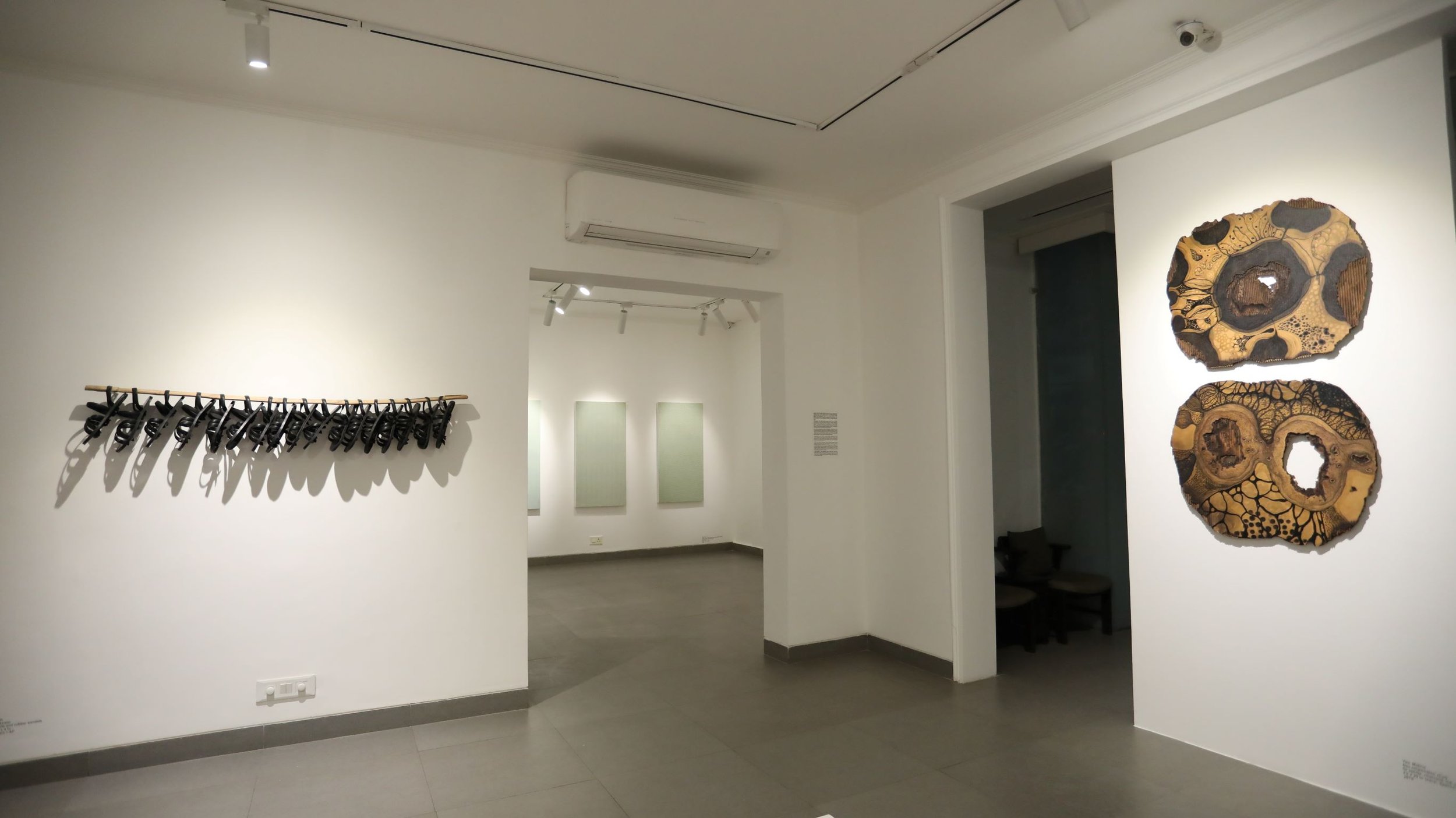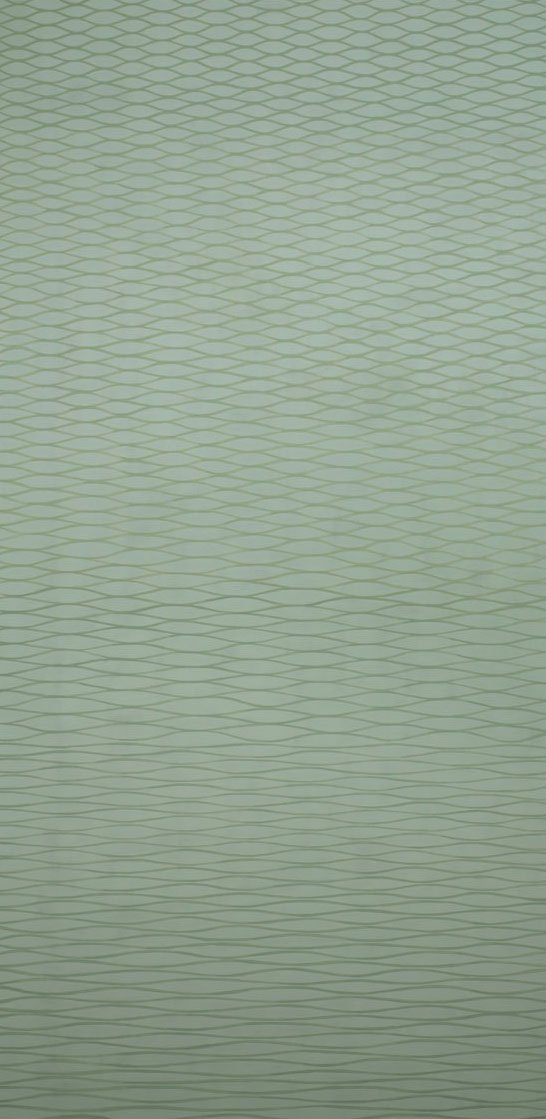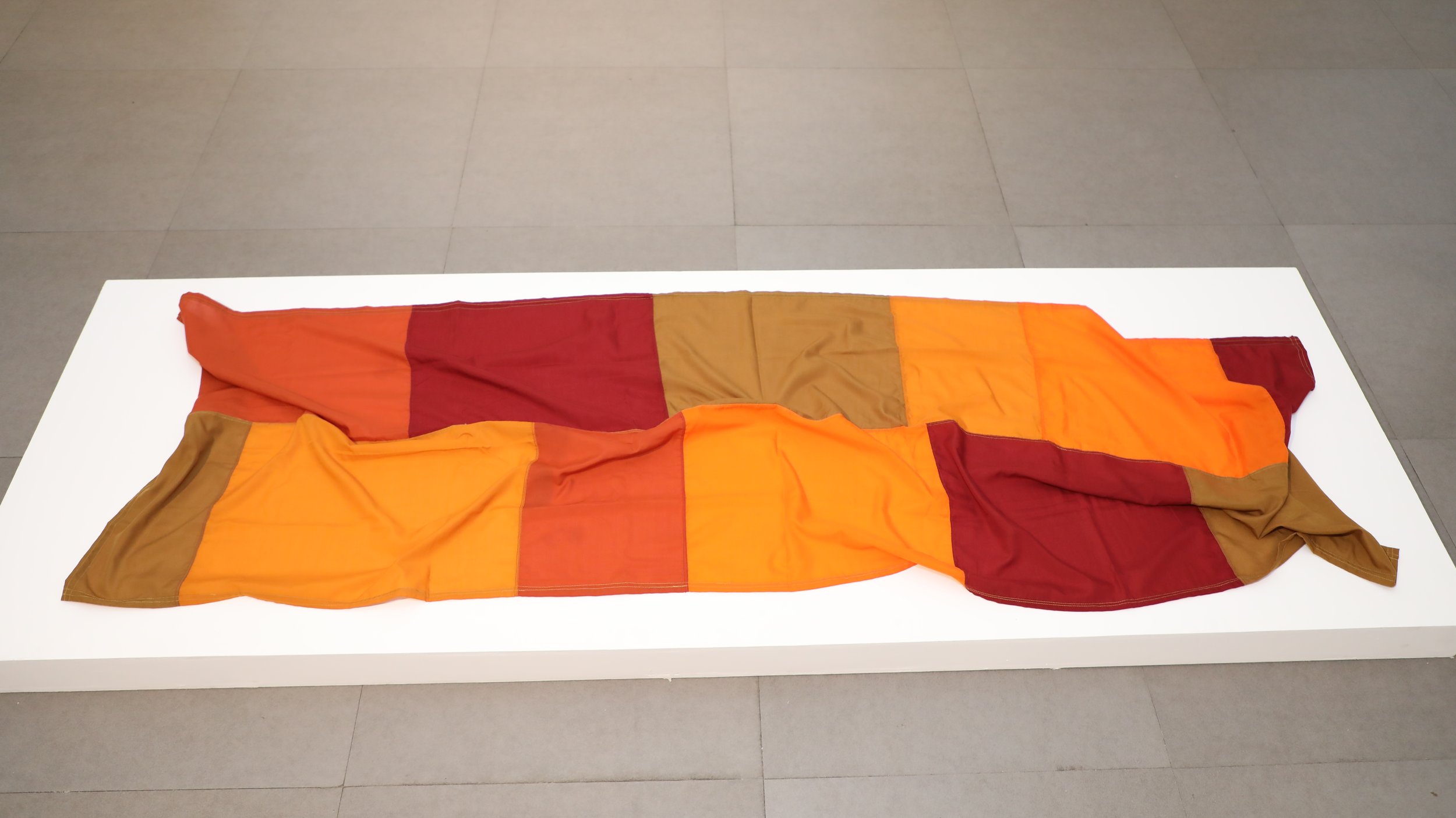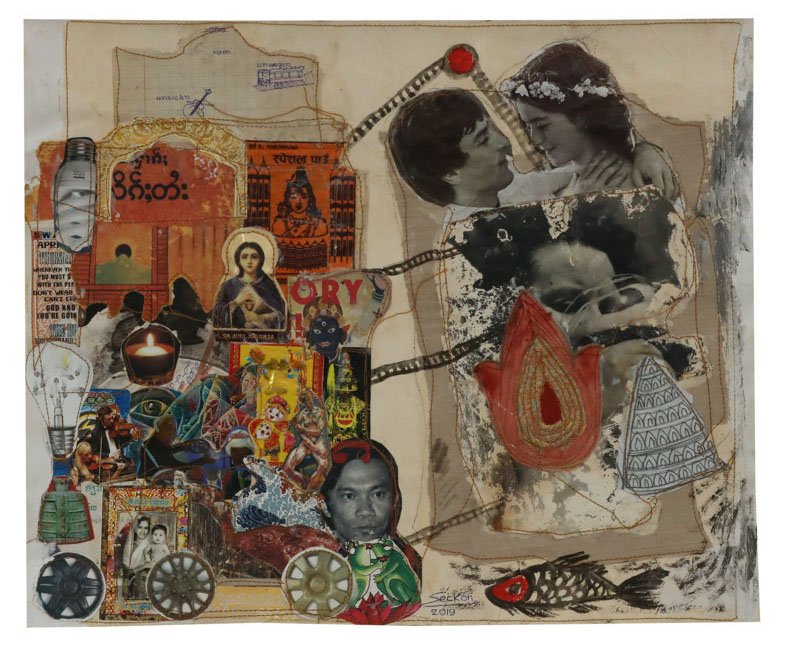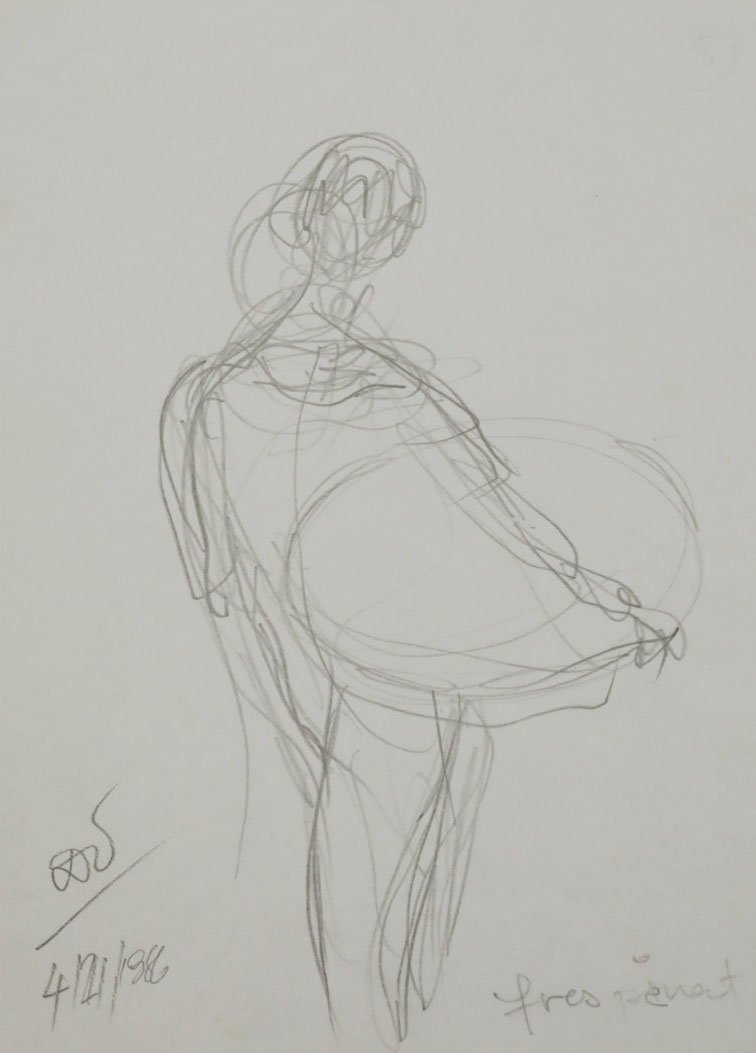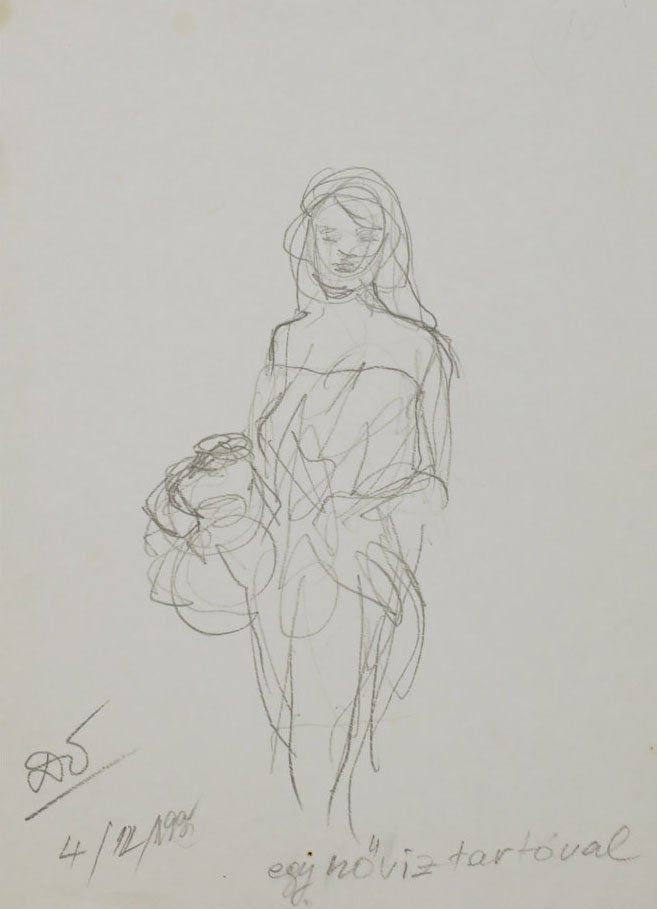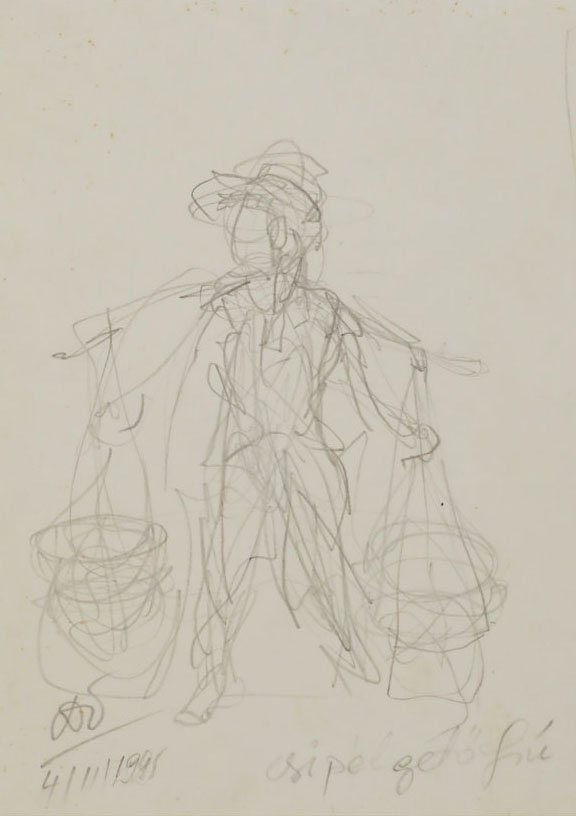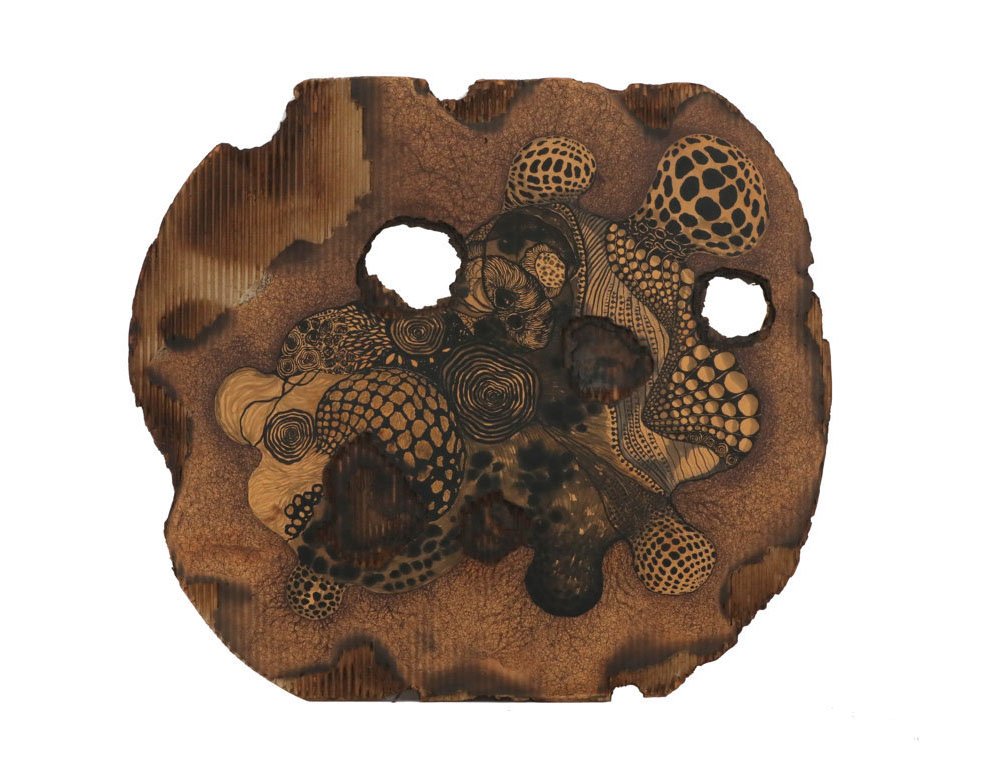
Out of Line: Tracing Abstraction within Contemporary Art in Cambodia
November 18, 2019 – December 20, 2019 at Akar Prakar, Delhi
Out of Line considers abstraction in the practices of ten leading artists born in Cambodia between 1933-1990 through conversations between the deviant and fecund potentials of its title. “Out of line” signals someone or something out of place, and assumes the need for correction, while it also points to potentiality through line; how line gives birth.
Dominant art historical narratives plot line’s behavior and function through time as a continuum: be it for language, symbol, ritual, narrative, or decoration, towards its status as a formal element of art treated within modernism’s value systems, to a conceptual and critical tool of the contemporary. The exhibition proposes all of these and more, simultaneously, when considering contemporary art in the Cambodian context.
The exhibition, divided into three sections, draws attention to how the artists have construed line in their personal desire for new relations – both freedom from and dialogue with – nationalized identities and aesthetics, through works of figural, partial or total abstraction.
The first section brings together figurative works by four generations of artists who have symbolically and literally enacted the etymological root of abstract: to ‘draw away’.
The late Svay Ken (1933-2008) is widely credited with marking and influencing the transition between “the modern” and “the contemporary” in the context of art in Cambodia. His self-taught, diurnal painting practice began at the age of sixty. With flattened planes, direct brushstrokes and subject matter elevating everyday life through seven political regimes, he defied the persistent uniformity around notions of beauty within academic perspectival realism. Two of his earliest oil paintings are exhibited here for the first time: Boy Peeling Sugar Cane and Hidden Body and Face (1995).
A row of rare early figure drawings by Suos Sodavy (b. 1955), made during his studies in Hungary, are relics of a post-Khmer Rouge education-building program under the then Soviet-friendly Vietnamese-ruling government in Cambodia (1979-1991). Sodavy’s confident, unembellished outlines evince movement, enlivening popular subject matter from colonial (1863-1953) and Independence-era (1953-1970) regimes banned during Khmer Rouge rule (1975-1979).
Svay Sareth’s (b. 1972) drawing studies in a refugee camp art program led to the co-founding of the important non-governmental Phare Ponleu Selpak art school in Battambang, followed by a decade of studies in France. His practice employing futility and coded resistance is palpable in his video self-portrait, I, Svay Sareth, eat rubber sandals (2015). Staging an absurd meal at the site of an impoverished fishing village, the artist chews and spits out the black rubber sandals that are highly symbolic of regional Cold War communism and its legacies.
Like many artists of his generation, Nov Cheanick (b. 1990) rejects perpetuating iconographies associated with Cambodia for fear of, in his words, “reducing the vision of culture.” Cheanick studied at Phare and also in France, and his decade of painting shows an expressive search for freedom from representation. Sitter (2012), exemplifies this as a redaction of identity, and marks one of the artist’s final figurative works before moving towards all over abstraction concerned with metaphysical systems.
In Cambodia, kbach is an ancient and evolving design code drawn from nature, whose infinite versatility and pervasive application grants cultural identity to all it adorns, from objects to garments to architecture. The second section routes abstraction through kbach in the work of three artists.
Than Sok (b. 1984) investigates religious and spiritual beliefs, materials and rituals across media. His most recent series, Kbach Teuk (2019), is a reverence and reinvention of traditional water forms. Canonical representations of water in Cambodian Hindu and Buddhist temple painting are mostly background, secondary or complimentary to human and mythical characters’ drama. In Sok’s words, “The ancient stories relate to today. We are geographically divided by water, but water has the potential to bring us together.” Here, Sok isolates water as the subject itself, inventing new forms based on his personal memories, such as at the spiritual confluence of the Mekong and Tonlé Sap rivers, or the shared pond in his home village.
Chan Dany’s (b. 1984) practice reinterprets cultural forms by embracing play as a form of preservation. His ongoing Sampot series considers the traditional garment’s changing kbach, colours and fibres, which have always been associated with culture, status, gender and age of the wearer. Fine silks, dyes, and loom weaving are being replaced with synthetic material, chemical colour and machine processes. Using industrial sheet plastic as his base, Dany hand-cuts and applies vinyl sticker and decorative appliqués into unwearable sampots that playfully acknowledge changing notions of desirability.
From pictographic or textual neon tubing and other minimalist urban forms, lines are a primary subject matter for Sin Many (b. 1990). His Entrance series (2019 -) transforms discarded iron window grating and doors whose kbach express both natural and geometric sensibilities. By recomposing (welding) and tracing (charcoal rubbing), Many is interested in honouring and preserving the blacksmiths’ original designs while, in his words, “giving a second life, creating a new view, a potential escape to an imaginary other side in this midst of change.”
A sense of rawness pervades this gallery in works that have challenged long-standing notions of skillful artisanal practice and material preciousness. Holding the space from both sides are works by two of Cambodia’s leading female artists, Tith Kanitha and Yim Maline, whose intuitive-led practices with utilitarian materials differently express a tangled relationship between inner and outer worlds. Works in collage and assemblage by Leang Seckon, Than Sok, Svay Sareth, use highly symbolic materials to challenge ideological power.
Tith Kanitha (b. 1987) resists authorities deemed inherited, linear, and rational; acknowledging instinct and play is a right, a discipline, and a means to empower the unconscious, the somatic, and the imperfect. She asks, “how can I make freedom physical?” Kanitha laboriously hand-coils and transforms her material - thin gage steel wire – until the forms, in her words, “can breathe on their own.” This process, a kind of drawing with wire, is her tactile means of tracing time and resisting conformity. Seeking relation both within and beyond her society, her sculptures are “not made to be believed in or prayed to; their spirit is abstract.”
The meticulous drawings and sculptures of Yim Maline (b. 1982) respond to local and global climatic and cultural change with materials invoking her childhood memories of playfully repurposing natural and found materials during impoverished times of civil war. Decomposition (Cut) (2016) poses as precious tree slices whose unlikely rings are out of sync with time – parasitic colonies attack and psychedelic growths huddle on their surfaces. She asks what can grow from the complex deaths, the decompositions, of today’s environmental and cultural change.
Leang Seckon (b. early 1970s) is a natural and gifted storyteller whose works combine autobiography, myth, religion, politics and popular culture. Seckon collects ephemera from everywhere he goes, from demolition sites to exhibition openings in Cambodia, to the streets where he travels globally. He sews a meandering line between and around these bits and pieces to form unlikely, critical, and powerful connections across time and space.
For Srie Bun II (2015), Than Sok (b. 1984) is made from extracted pieces of Buddhist clerical garments whose colours signify ranks within the two sects of Cambodia’s Theravada Buddhist systems. Historically, the robe’s rectilinear form and seams imitate those of the rice field. The Buddhist monk, wearing robes, is believed to delineate a merit field comparable to the fertile rice field, where seeds are sown for reaping. The word veal srie in the Khmer language means rice field, and bun refers to merit making and ceremony. Sok’s gesture questions the robe’s symbolic power and how peace can be advanced when hierarchical notions of sect and rank remain at the moral core of society.
In Svay Sareth’s (b. 1972) assemblage, Stake or Skewer (2015), black rubber sandals weight a noodle vendor’s carrying pole with the number of years the artist was forced to live within the physical and psychological borders of labour and refugee camps. For Sareth, the pole acts as a stake for border makers and a skewer for those who step out of line.
Erin Gleeson
Chan Dany | Sampot: Civilisé (Elegant Girl) | Mylar and vinyl sticker, rhinestone on plastic board | 31 x 21.5 in | 2019
Chan Dany | Sampot: Civilisé (City Girl) | Mylar and vinyl sticker, rhinestone on plastic board | 23 x 17 in | 2019
Chan Dany | Sampot: Civilisé (My Mother) | Mylar and vinyl sticker, rhinestone on plastic board | 27 x 19.5 in | 2019
Chan Dany | Sampot: Civilisé (My Mother) | Mylar and vinyl sticker, rhinestone on plastic board | 27 x 19.5 in | 2019
Chan Dany | Sampot: Civilisé (My Mother) | Mylar and vinyl sticker, rhinestone on plastic board | 27 x 19.5 in | 2019
Chan Dany | Sampot: Civilisé (My Mother) | Mylar and vinyl sticker, rhinestone on plastic board | 27 x 19.5 in | 2019
Thank Sok | Kbach Teuk Tonlé Chaktomuk During Water Festival with My Father, Phnom Penh | Acrylic on canvas | 47.5 x 24 in | 2019
Thank Sok | Kbach Teuk Tonlé Chaktomuk During Water Festival with My Father, Phnom Penh | Acrylic on canvas | 47.5 x 24 in | 2019
Thank Sok | Kbach Teuk Tonlé Chaktomuk During Water Festival with My Father, Phnom Penh | Acrylic on canvas | 47.5 x 24 in | 2019
Sin Many | Entrance 1 | Charcoal on recycled paper | 72 x 158 cm | 2019
Sin Many | Entrance 3 | Charcoal on recycled paper | 48 x 76 cm | 2019
Nov Cheanick | Sitting | Acrylic, ink and pencil on canvas | 52.5 x 43.5 in | 2012
Svay Sareth | Digital Still from I, Svay Sareth, eat rubber sandals | Single-channel HD video, color, sound | 2015
Svay Sareth | Stake or Skewer | Wooden pole and rubber sandals | 58.5 x 11.5 x 4 in | 2015
Svay Ken | Boy peeling Sugar Cane | Oil on canvas | 23 x 19.5 in | 1995
Svay Ken | Hidden Body and Face | Oil on canvas | 15.5 x 10.5 in | 1995
Than Sok | Srie Bun II | Cotton | 28 x 88 in | 2015
Leang Seckon | Our Thoughts Are Similar | Collage on canvas | 17 x 21 in | 2019
Leang Seckon | Pain Advanced Development | Collage on canvas | 16 x 20 in | 2019
Leang Seckon | Fly Out of Tuol Sleng | Collage on canvas | 17 x 21 in | 2019
Suos Sodavy | Untitled | Graphite on paper | 20 x 27 cm
Suos Sodavy | Untitled | Graphite on paper | 21 x 29.5 cm
Suos Sodavy | Untitled | Graphite on paper | 21 x 29.5 cm
Suos Sodavy | Untitled | Graphite on paper | 21 x 29.5 cm
Suos Sodavy | Untitled | Graphite on paper | 18 x 27 cm
Suos Sodavy | Untitled | Graphite on paper | 20 x 27 cm
Tith Kanitha | Untitled | Hand coiled steel wire | 55 x 9 x 10 in | 2019
Tith Kanitha | Untitled | Hand coiled steel wire | 87 x 18 x 6 in | 2019
Tith Kanitha | Untitled | Hand coiled steel wire | 12 x 14 x 14 in | 2019
Tith Kanitha | Untitled | Hand coiled steel wire | 35 x 21 x 11 in | 2019
Tith Kanitha | Untitled | Hand coiled steel wire | 24 x 10 x 7 in | 2019
Tith Kanitha | Untitled | Hand coiled steel wire | 24 x 12 x 1 in | 2019
Yim Maline | Decomposition (Cut) | Graphite, charcoal, ink on cardboard | 25 x 29 in | 2016
Yim Maline | Decomposition (Cut) | Graphite, charcoal, ink on cardboard | 25 x 29 in | 2016
Yim Maline | Decomposition (Cut) | Graphite, charcoal, ink on cardboard | 25 x 29 in | 2016
Yim Maline | Decomposition (Cut) | Graphite, charcoal, ink on cardboard | 25 x 29 in | 2016
Yim Maline | Decomposition (Cut) | Graphite, charcoal, ink on cardboard | 25 x 29 in | 2016
Out of Line | Artist Biographies
Chan Dany (born 1984, Prey Veng) is known for reinterpreting ancient cultural forms and practices that embrace play as a form of preservation. His solo exhibitions include Sampot: The Collection of Small Things (2013) and If They Were With Us Today (2012), both at SA SA BASSAC, Phnom Penh. Select group exhibitions include: Sovereign Asian Art Prize Finalist Exhibition, Hong Kong (2017); Shapeshifting: Contemporary Art From Southeast Asia, 10 Chancery Lane Gallery, Hong Kong (2016); And That Which Was Always Known, Yavuz Gallery, Singapore; and Swimming in Sand; Growing Rice Under an Umbrella, No Vacancy, Melbourne, Australia (2014). Dany studied traditional forms and practices as well as contemporary art at the Art School of Reyum Institute of Art and Culture in Phnom Penh, graduating in 2007. He is based in Phnom Penh.
Leang Seckon (born 1970s, Prey Veng) works primarily in painting and collage to construct narratives that combine autobiography, myth, religion, politics and popular culture. Seckon’s solo exhibitions include: Prophecy, McNichols Civic Center Building, Denver (2019); When Head and Body Unite, Rossi & Rossi, Hong Kong (2017); and Influence: The New Age, Java Gallery, Phnom Penh (2016). Notable group exhibitions include: reBIRTH reVITALISE reGENERATION, National Museum of Cambodia, Phnom Penh (2017); 8th Asia Pacific Triennial of Contemporary Art, QGOMA, Brisbane (2015); Shanghai Biennale (2012); and 4th Fukuoka Asian Art Triennale, Japan (2009). Seckon has held residencies in the USA and Japan. He holds a BA, Plastic Arts (1996) and Design (2002), Royal University of Fine Arts, Phnom Penh. Seckon is based in Phnom Penh.
Nov Cheanick’s (born 1989, Site 2 refugee camp, Thailand-Cambodian border) painting practice is grounded in his meditation practice and related metaphysical systems. Solo exhibitions include: De-Rives, Pavillon André Citröen, Paris (2019), Cycle, Rosewood Hotel Gallery, Phnom Penh (2018), and Break the System, Lee Gallery, Paris and Sangker Gallery, Battambang, (both 2017). Group exhibitions include: Shapeshifting: Contemporary Art from Southeast Asia, 10 Chancery Lane Gallery, Hong Kong (2015); Made in Battambang, French Institute, Phnom Penh (2014), and The Memory Workshop, Maison Français, Columbia University, NYC (2013). He studied visual art at Phare Ponleu Selpak in Battambang, graduating in 2010, and continued studies at École Pivaut in Nantes, France (2011). Since 2019, Cheanick is based in Nantes.
Than Sok (born 1984, Takeo) investigates religious and spiritual beliefs, materials and rituals through sculpture, installation, video and performance. Sok’s recent solo exhibitions include: Currents, Richard Koh Fine Art, Singapore (2019) and Klah Klok, SA SA BASSAC, Phnom Penh (2018). Group exhibitions include: A Beast, A God, and A Line, Museum of Modern Art, Warsaw, Poland; Dhaka Art Summit, Bangladesh; Myanmar, Yangon; and Parasite, Hong Kong (2018); SUNSHOWER: Contemporary Art in Southeast Asia from 1980 to today, Mori Art Museum, Tokyo, Japan (2017); Haunted Thresholds, Spirituality In Contemporary Southeast Asia, Kunstverein Gottingham, Germany (2014); Sights and Sounds: Global Video Art, The Jewish Museum, NYC (2013). Sok has held residencies in Vietnam, USA, and Japan. He studied traditional forms and practices as well as contemporary art at the Art School of Reyum Institute of Art and Culture in Phnom Penh, graduating in 2007. Sok’s work is collected by the Singapore Art Museum and MAIIAM Contemporary Art Museum. Sok is based in Phnom Penh.
Tith Kanitha (born 1987, Phnom Penh) has a multidisciplinary practice that values intuition. Her recent solo exhibition was Instinct, SA SA BASSAC, Phnom Penh (2018) and group exhibitions include: Present Passing: South by Southeast, Osage Art Foundation, Hong Kong (2019); Break, Bind, and Rebuild, A+, Kuala Lumpur, Malaysia (2019); Le paysage après coup, Centre d'art contemporain Faux Mouvement, Metz (2018) SUNSHOWER: Southeast Asian Art from 1980s to Today, Mori Art Museum, Tokyo (2017); Asia Now, Paris Asian Art Fair (2016), and The Memory Workshop, Columbia University, NYC (2013). Kanitha’s work is collected by Singapore Art Museum and MAIIAM Contemporary Art Museum. She has held residencies in Japan, South Korea, Taiwan, Myanmar, and the USA. She is currently based in Amsterdam the Rijksacademie residency program (2019-2021).
Sin Many’s (born 1990, Battambang) practice across media embraces minimalism to reflect on complex environmental and emotional worlds. He is one of a growing number of self-taught artists of his generation in Cambodia. He co-founded the artist collective HOMELESS, which exhibits regularly across the country. Many was awarded a Creative Generation Award leading to his first solo exhibition, Signs, Java Café, Phnom Penh (2018). Group exhibitions include, Personnes and Espace, French Institute; Creative Generation, Futures Factory (both Phnom Penh, 2019); and Being no one and going nowhere, Buoy Arts Center, Tokyo (2018). Many holds a BS, Banking and Finance, University of Battambang. He is based in Phnom Penh.
Suos Sodavy’s (born 1955, Kandal) painting practice spans his influences from two distinct education systems during Cold War transitional periods in Cambodia and Hungary. His solo exhibitions include Suos Sodavy: Four Ways In, Rosewood Hotel Gallery, Phnom Penh (2019) and Walking Markets, Java Café and Gallery, Phnom Penh (2010). Recent group exhibitions include: Thailand Biennale 2018, Krabi (2018) and Robam, Metahouse, Phnom Penh (2016). Sodavy graduated from the International Language School (1986) and Teacher Training College of Nyfreghàza, Hungary (1989). He holds an MFA, Department of Painting, Academy of Fine Arts, Budapest, Hungary (1994). For the past 25 years, he has been a Professor in the Faculty of Fine Arts, Royal University of Fine Arts, Phnom Penh, and has held various roles within Cambodia’s Ministry of Culture and Fine Art. Sodavy is based in Phnom Penh.
Svay Ken (1933, Takeo – 2008, Phnom Penh) is often credited with marking and influencing the transition between “the modern” and “the contemporary” in the context of art in Cambodia, through direct, autobiographical paintings about life lived through seven distinct political regimes. From a family of temple painters, he began painting at the age of sixty after a lifetime working as cleaner, server and concierge at Raffles Hotel in Phnom Penh. Solo exhibitions include Sharing Knowledge, Bophana Audiovisual Resource Center, Phnom Penh (2008) and Painted Stories: The Life of a Cambodian Family from 1941 to the Present, Reyum Institute of Art and Culture, Phnom Penh (2001). Select group exhibitions include: SUNSHOWER: Contemporary Art from Southeast Asia from 1980s to Today, National Art Center Tokyo (2018); Phnom Penh: Rescue Archaeology, ifa, Berlin and Stuttgart (2013); and 6th Asia Pacific Triennial of Contemporary Art, QGOMA, Brisbane (2009). His work is in prominent public collections including Singapore Art Museum, National Gallery of Singapore, Queensland Art Gallery, and Fukuoka Asian Art Museum.
Svay Sareth’s (born 1972, Battambang) multidisciplinary practice is rooted in resistance, traversing both present and historical moments. His solo exhibitions include: The Breath of Change, Richard Koh Fine Art, Singapore (2019); Home, Lost and Found, Batia Sarem, Siem Reap (2019); I, Svay Sareth, eat rubber sandals, SA SA BASSAC, Phnom Penh (2015). Group exhibitions include: Gods, Heroes and Clowns: Performance and Narrative in South and Southeast Asian Art, National Gallery of Victoria, Melbourne, Australia; Secret Archipelago, Palais de Tokyo, Paris (both 2016); and If The World Changed, 4th Singapore Biennale (2013). In 2016, he won the Prudential Eye Award Best Emerging Artist Using Sculpture and Overall Best Emerging Artist. He holds an MFA, L’école Régional Supérieur des Beaux-Arts de Caen, France (2009). His work is collected by Singapore Art Museum, National Gallery of Victoria, and MAIIAM Contemporary Art Museum. Sareth is based in Siem Reap.
Yim Maline’s (born 1982, Battambang) meticulous drawings and sculptures reflect on local and global climatic and cultural change. Her recent solo exhibitions include: The Shadow of Change, Richard Koh Fine Art, Singapore (2019); Home, Lost and Found, Batia Sarem, Siem Reap (2019); and Decomposition, University of Wyoming Art Museum (2016). Group exhibitions include: Cambodia: Looking Back on the Future, Finn Gallery, CT (2017); And that which was always known, Yavuz Gallery, Singapore (2015), and Eight Women, French Institute, Phnom Penh (2011). Maline has held residencies in South Africa, Japan, Andorra and the USA. She studied visual arts at Phare Ponleu Selpak art school in Battambang (1995-2001) and holds a Certificate, Fine Art, École des Beaux-Arts de Beauvais (2003), and a BFA, Fine Art, École Supérieure des Beaux-arts de Caen, France (2010). Maline is based in Siem Reap.
Out of Line | Curator Biography
Erin Gleeson is a curator, researcher and writer. From 2011-2018, Erin was the co-founding director and curator of SA SA BASSAC, a non-profit exhibition space, reading room and resource centre in Phnom Penh. Her recent curatorial work includes: Elevations Laos, Vientiane (2018); On Attachments and Unknowns, SA SA BASSAC, Phnom Penh (with May Adadol Ingawanij, 2017); and Satellite Program 8, Jeu de Paume, Paris, and CAPC, Bordeaux (2015-2016). Recent speaking engagements include: Journey in the Dreams of the Children at the Border, Curatorial Practices in Asia, Rockbund Art Museum, Shanghai; Experimenter Curator’s Hub, Kolkata; Body Blocs: Cham Space in Vietnam and Cambodia, Myanm/art, Yangon (all 2018); Flight from the Empire, House of World Cultures, Berlin; SUNSHOWER: Contemporary Art from Southeast Asia from 1980-Today, Mori Art Museum, Tokyo (both 2017). Erin’s writing is forthcoming in: From a History of Exhibitions Towards a Future of Exhibition-Making: China and Southeast Asia, Sternberg Press; Minstrel Kuik, a monograph, Skira; and Geneology of Bassac, Graham Foundation (all 2020). She holds an MA, Contemporary Art and Art Theory of Asia and Africa, SOAS, University of London.
